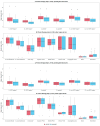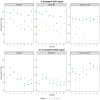Clinical Introduction of Stem Cell Sparing Radiotherapy to Reduce the Risk of Xerostomia in Patients with Head and Neck Cancer
- PMID: 39766181
- PMCID: PMC11674908
- DOI: 10.3390/cancers16244283
Clinical Introduction of Stem Cell Sparing Radiotherapy to Reduce the Risk of Xerostomia in Patients with Head and Neck Cancer
Abstract
Background/objectives: Studies have shown that dose to the parotid gland stem cell rich (SCR) regions should be reduced to lower the risk of xerostomia after radiotherapy (RT). This study aimed to assess whether stem cell sparing (SCS)-RT can be adopted in routine clinical practice.
Methods: Multiple planning studies were performed to compare SCS-RT with standard (ST)-RT using 30 head and neck cancer patients. Shifts in mean dose to the SCR regions (Dmean,SCR) and other organs at risk and their estimated impact on normal tissue complication probability (NTCP) for side-effects were compared using Wilcoxon signed-rank test. A multicenter study was performed (eight institutions, three patients) to test the generalizability of SCS-RT using the Friedman test.
Results: Using photons, Dmean,SCR was reduced with median 4.1/3.5 Gy for ipsilateral/contralateral (p < 0.001). The largest reductions were when the SCR regions overlapped less with target volumes. Subsequently, NTCPs for xerostomia decreased (p < 0.001). Using protons, Dmean,SCR was also reduced (2.2/1.9 Gy for ipsilateral/contralateral, p < 0.002). Nevertheless, SCS-RT did not further decrease NTCPs for xerostomia (p > 0.17). Target coverage and prevention of other side-effects were not compromised. However, increased mean oral cavity dose was observed in some patients. Lastly, in the multicenter study Dmean,SCR could be reduced by slightly adjusting the standard optimization. Contralateral Dmean,SCR reductions differed between centers (p = 0.01), which was attributed to differences in ST-RT plans.
Conclusions: Stem cell sparing radiotherapy can be clinically introduced by making small adjustments to the optimization strategy and can reduce the risk of xerostomia.
Keywords: head and neck cancer; parotid gland stem cells; stem cell sparing radiotherapy; xerostomia.
Conflict of interest statement
The authors declare no conflicts of interest. The funders had no role in the design of the study; in the collection, analyses, or interpretation of data; in the writing of the manuscript; or in the decision to publish the results.
Figures




Similar articles
-
Radiation-induced Xerostomia is Related to Stem Cell Dose-dependent Reduction of Saliva Production.Int J Radiat Oncol Biol Phys. 2024 Nov 1;120(3):772-782. doi: 10.1016/j.ijrobp.2024.04.012. Epub 2024 Apr 15. Int J Radiat Oncol Biol Phys. 2024. PMID: 38631537
-
Prediction of Radiation-Induced Parotid Gland-Related Xerostomia in Patients With Head and Neck Cancer: Regeneration-Weighted Dose.Int J Radiat Oncol Biol Phys. 2023 Nov 1;117(3):750-762. doi: 10.1016/j.ijrobp.2023.04.034. Epub 2023 May 6. Int J Radiat Oncol Biol Phys. 2023. PMID: 37150262
-
Parotid Gland Stem Cell Sparing Radiation Therapy for Patients With Head and Neck Cancer: A Double-Blind Randomized Controlled Trial.Int J Radiat Oncol Biol Phys. 2022 Feb 1;112(2):306-316. doi: 10.1016/j.ijrobp.2021.09.023. Epub 2021 Sep 24. Int J Radiat Oncol Biol Phys. 2022. PMID: 34563635 Clinical Trial.
-
Using a reduced spot size for intensity-modulated proton therapy potentially improves salivary gland-sparing in oropharyngeal cancer.Int J Radiat Oncol Biol Phys. 2012 Feb 1;82(2):e313-9. doi: 10.1016/j.ijrobp.2011.05.005. Epub 2011 Jun 25. Int J Radiat Oncol Biol Phys. 2012. PMID: 21708427
-
The role of stem cells in the prevention and treatment of radiation-induced xerostomia in patients with head and neck cancer.Cancer Med. 2016 Jun;5(6):1147-53. doi: 10.1002/cam4.609. Epub 2016 Feb 16. Cancer Med. 2016. PMID: 26880659 Free PMC article. Review.
References
-
- Van den Bosch L., van der Schaaf A., van der Laan H.P., Hoebers F.J., Wijers O.B., van den Hoek J.G., Moons K.G., Reitsma J.B., Steenbakkers R.J., Schuit E., et al. Comprehensive toxicity risk profiling in radiation therapy for head and neck cancer: A new concept for individually optimised treatment. Radiother. Oncol. 2021;157:147–154. doi: 10.1016/j.radonc.2021.01.024. - DOI - PubMed
-
- Onjukka E., Mercke C., Björgvinsson E., Embring A., Berglund A., von Döbeln G.A., Friesland S., Gagliardi G., Helleday C.L., Sjödin H., et al. Modeling of Xerostomia After Radiotherapy for Head and Neck Cancer: A Registry Study. Front. Oncol. 2020;10:1647. doi: 10.3389/fonc.2020.01647. - DOI - PMC - PubMed
-
- Li Y., Sijtsema N.M., de Vette S.P.M., Steenbakkers R.J.H.M., Zhang F., Noordzij W., Van den Bosch L., Langendijk J.A., van Dijk L.V. Validation of the 18F-FDG PET image biomarker model predicting late xerostomia after head and neck cancer radiotherapy. Radiother. Oncol. 2023;180:109458. doi: 10.1016/j.radonc.2022.109458. - DOI - PubMed
LinkOut - more resources
Full Text Sources

